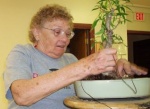Princess Persimmon
3 posters
Page 1 of 1
 Princess Persimmon
Princess Persimmon
I was surprised that there is nothing here on this species, Diospyros rhombifolia. Apparently it is popular in Japan, where it is typically displayed in winter with fruit on it. I was given one in exchange. Any care suggestions? Picture will follow when I get to it.
Iris
Iris

bonsaisr- Member
 Re: Princess Persimmon
Re: Princess Persimmon
I know more about the native persimmon, not so much about D. rhombifolia. D. rhombifolia is at best zone 7 hardy. Pruning branches before they have hardened off can cause the entire branch to fail. So only prune very late summer, or in autumn, or wait until just before new growth gets growing in spring. Beyond that I am not very familiar. They also have separate sexes. Trees from seed will be either male or female. I've seen notes on Wikipedia and other places (which have not been verified or peer reviewed  ) that the ratio is roughly 50:50 for the sexes. Which means if you pick up 6 seedlings chances are pretty good you will have one of each sex. Cuttings are a better way to get female trees.
) that the ratio is roughly 50:50 for the sexes. Which means if you pick up 6 seedlings chances are pretty good you will have one of each sex. Cuttings are a better way to get female trees.
Seed to first blooming can be as little as 7 years, but longer if growth was pruned back often and hard. In a pot, it is not unusual for a seedling to take 10+ years to bloom. Rumore has it the Princess Persimmon is inedible. In theory all the Diospyros fruit are edible, but some definitely are better tasting than others. D. rhomibifolia has had comments posted about it being small, dry and very astringent even when soft-ripe. In my opinion the American persimmon has a flavor that is better than the Japanese persimmon, D. kaki, at the kaki I have been able to get at my grocery store. I do recognize that a tree ripened D.kaki will be worlds better in flavor than a picked green stored for months and then shipped store bought D. kaki.
Anyone else know something?, as my comments are mostly from reading and a bit of hands on with American persimmon.
Seed to first blooming can be as little as 7 years, but longer if growth was pruned back often and hard. In a pot, it is not unusual for a seedling to take 10+ years to bloom. Rumore has it the Princess Persimmon is inedible. In theory all the Diospyros fruit are edible, but some definitely are better tasting than others. D. rhomibifolia has had comments posted about it being small, dry and very astringent even when soft-ripe. In my opinion the American persimmon has a flavor that is better than the Japanese persimmon, D. kaki, at the kaki I have been able to get at my grocery store. I do recognize that a tree ripened D.kaki will be worlds better in flavor than a picked green stored for months and then shipped store bought D. kaki.
Anyone else know something?, as my comments are mostly from reading and a bit of hands on with American persimmon.

Leo Schordje- Member
 Princess Persimmon
Princess Persimmon
I'm not growing it to eat, so I am not concerned about the taste. 
I saw some comments about leaf damage. Mine looks fine so far, even though we are having a terrible lot of rain.
I didn't realize it until now, but ebony trees belong to the same genus & they all have tasty fruit.
Korean hornbeam is also hardy to Zone 7. If I can manage that over the winter, the persimmon should be OK.
The Hebrew name is efarsemon. אֲפַרסְמוֹן
Iris

I saw some comments about leaf damage. Mine looks fine so far, even though we are having a terrible lot of rain.
I didn't realize it until now, but ebony trees belong to the same genus & they all have tasty fruit.
Korean hornbeam is also hardy to Zone 7. If I can manage that over the winter, the persimmon should be OK.
The Hebrew name is efarsemon. אֲפַרסְמוֹן
Iris

bonsaisr- Member
 Re: Princess Persimmon
Re: Princess Persimmon
I hope your princess persimmon does well for you. I chuckled about the not growing it to eat. If you saw how rotund I am, you would know that I love food, its a fascination for me, especially when I have been dieting. 
Like you, I have a fascination with all things botanical. I suspect the species of persimmon that occurs most often in the middle east, & southern eastern Europe, would be Diospyros lotax, it has been used as a food, and I know has been mentioned in many historical documents, including some ancient Greek and Roman texts.
I was talking with a botanist, who was doing a diversity study for a national government, to help pick boundries for a National Park in tropical asia. We were talking about ebony. The black wood of ebony is the heartwood, the sapwood is a light yellow. Ebony needs to mature to at least 100 years of age before the black heartwood begins to form. It adds black heartwood only at the rate of approximately 1 inch (2.5 cm) per 100 years. Average harvested ebony tree only has approximately 5 inches diameter of heartwood, meaning at harvest most Ebony trees are about 500 years old. Ebony is NOT a renewable resource. The regeneration time is so long that is must be viewed as a limited non-renewable resource. The world needs to protect the few remaining wild stands of the various ebony species. He said all members of Diospyros will make some black hearwood, with extreme age, but only a few species ever get large enough, that harvest is possible. There are only half a dozen species that can be harvested for ebony, all are tropical. A couple are from Africa, the rest are tropical south east Asia.
What is interesting, I have personally seen the black heart wood of ebony in the American persimmon. It was in a tree that was most likely well over 100 years old, felled by a storm. The core was less than an inch diameter, but it was there. Absolutely no rot in the tree, but the storm was fierce and the tree came down with the others around it. I have not seen the black heartwood in younger trees. Diospyros is a fascinating genus of trees.
Like you, I have a fascination with all things botanical. I suspect the species of persimmon that occurs most often in the middle east, & southern eastern Europe, would be Diospyros lotax, it has been used as a food, and I know has been mentioned in many historical documents, including some ancient Greek and Roman texts.
I was talking with a botanist, who was doing a diversity study for a national government, to help pick boundries for a National Park in tropical asia. We were talking about ebony. The black wood of ebony is the heartwood, the sapwood is a light yellow. Ebony needs to mature to at least 100 years of age before the black heartwood begins to form. It adds black heartwood only at the rate of approximately 1 inch (2.5 cm) per 100 years. Average harvested ebony tree only has approximately 5 inches diameter of heartwood, meaning at harvest most Ebony trees are about 500 years old. Ebony is NOT a renewable resource. The regeneration time is so long that is must be viewed as a limited non-renewable resource. The world needs to protect the few remaining wild stands of the various ebony species. He said all members of Diospyros will make some black hearwood, with extreme age, but only a few species ever get large enough, that harvest is possible. There are only half a dozen species that can be harvested for ebony, all are tropical. A couple are from Africa, the rest are tropical south east Asia.
What is interesting, I have personally seen the black heart wood of ebony in the American persimmon. It was in a tree that was most likely well over 100 years old, felled by a storm. The core was less than an inch diameter, but it was there. Absolutely no rot in the tree, but the storm was fierce and the tree came down with the others around it. I have not seen the black heartwood in younger trees. Diospyros is a fascinating genus of trees.

Leo Schordje- Member
 Re: Princess Persimmon
Re: Princess Persimmon
My two cents...
I had some friends bring back seeds from Japan. They may have started blooming after 7 years but it seemed sooner, and when they did start blooming there seemed to be more male than female plants. The flowers are very easy to tell apart. If you plan on wiring, do it when the growth is young and pliable. They sucker like crazy and are easy root cuttings. I cut the bottom half off a root ball, stuck it back in a pot and it sprouted like a little forest. A friend of mine had a big one he'd picked up somewhere. It sets fruit easily, but the closest same species pollenator is mine, about 25 miles away. I guess our native D. virginiana works too, or one of the Asian species could be lurking in a nearby garden - they are both around.
R

Russell Coker- Member
 Princess Persimmon
Princess Persimmon
Persimmons are known to set some fruit without a POLLENIZER (sic). Of course the fruit would probably be seedless, or have sterile seeds. The pollinator is the bee.
Iris
Iris

bonsaisr- Member
 Similar topics
Similar topics» TX Persimmon
» American Native genus/species for bonsai
» Texas Persimmon (Diospyros Texana) Tips Needed
» In praise of the American Persimmon, Diospyros virginiana some field photos
» American Native genus/species for bonsai
» Texas Persimmon (Diospyros Texana) Tips Needed
» In praise of the American Persimmon, Diospyros virginiana some field photos
Page 1 of 1
Permissions in this forum:
You cannot reply to topics in this forum|
|
|







